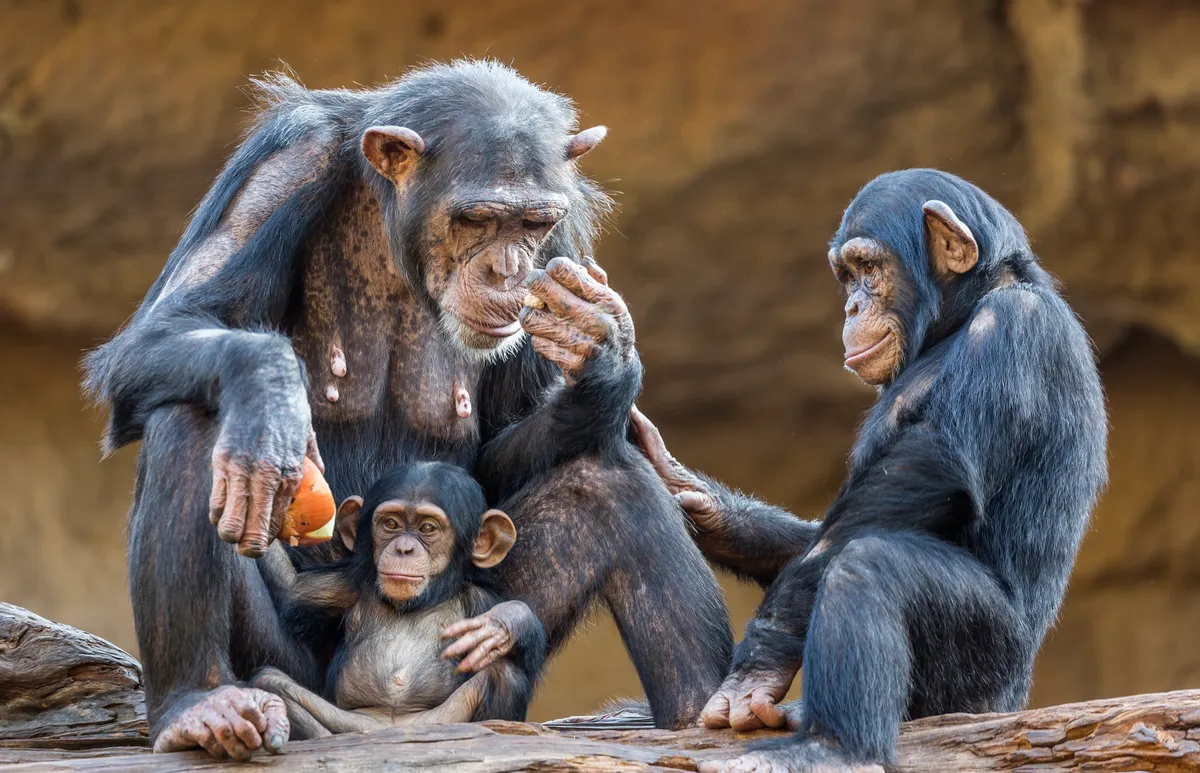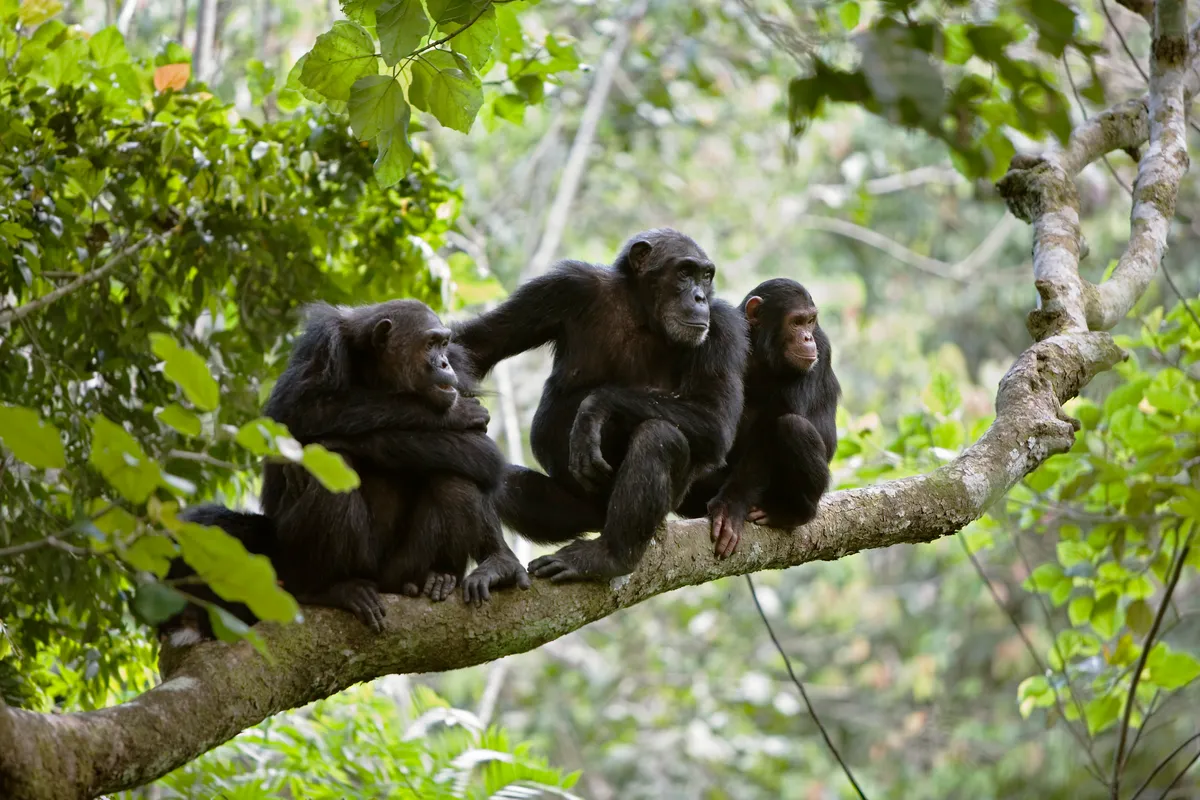Chimpanzees our one of our closest living relatives, and we share 98% of our genetic DNA with them. Like us, chimpanzees are hominids – or great apes – of which there are eight extant species in four genera: Homo (of which only we humans remain), Pongo (Bornean, Sumatran and Tapanuli orangutans), Gorilla (eastern and western gorillas) and (chimps and bonobos).
How many species of chimpanzee are there?
There are four confirmed subspecies of chimpanzee: Nigeria-Cameroon chimpanzee (Pan troglodytes ellioti), Central chimpanzee (P. t. troglodytes), Western chimpanzee (P. t. verus) and Eastern chimpanzee (P. t. schweinfurthii). A fifth proposed subspecies is the Southeastern chimpanzee (P. t. marungensis) but this is not currently recognised by the IUCN.
Chimpanzees are highly intelligent, with tool use common. Some chimpanzees even go as far as to sharpen sticks to use for hunting.
How clever are chimpanzees?
As well as using tools, some chimpanzees have been able to learn basic human sign language. Washoe, a captive female chimpanzee, was able to learn American Sign Language (ASL), with a vocabulary of 350 words.
A 2019 PNAS study suggested that chimpanzees, along with all great apes, possess a ‘Theory of mind’, a capacity once thought to be unique to humans. Those with a theory of mind have the cognitive ability to understand that others have mental states, beliefs, and desires that are different to their own.
This means that they are able to understand that the viewpoint of another may be different to what they see, and so others may form different beliefs. It is a critical aspect of human social interactions.
What do chimpanzees eat?
Chimpanzees are omnivorous, but eat fruit more than anything else. Most of a chimpanzee's diet comes from our bits of plants (seeds, leaves, roots, resin etc) but they will also eat insects, honey, birds and bird eggs, mammals and even soil.
Most shockingly of all, chimpanzees have been documented hunting other primates, and even committing cannibalistic infanticide.
However, the average chimpanzee diet is mostly fruit and plant matter, with insects and meat contributing just 2% of the total.

Where do chimpanzees live?
As a highly adaptable species, chimpanzees inhabit a range of habitats, including tropical rainforest, montane rainforests at altitudes of up to 3000m, swap forests, less densely vegetated forest-savannah mosaics, and even dry savannah.

How long do chimpanzees live?
The oldest recorded chimpanzee was Little Mamma, a captive female who was between 76 to 82 years old when she died in 2017. This record holder far exceeds the median life expectancy for captive chimps, which is 31.7 years for males and 38.7 years for females.
Chimpanzee lifespan in the wild is harder to gauge, but a recent study of 306 chimps at Ngogo in Uganda’s Kibale National Park showed the average life expectancy to be about 33 years. This is nearly twice as old as has been found for other chimpanzee groups, and about the same as the average lifespan of human hunter-gatherers.
But the Ngogo group is not a typical one. Unlike other groups studied, it inhabits a productive, healthy forest with low levels of human disturbance, so it might be a more accurate reflection of natural chimpanzee lifespan.

How do chimpanzees communicate?
Chimpanzees make around 30 different vocalisations. The most common and loudest is the pant-hoot, a long-distance call used for a variety of social reasons, but particularly for keeping in touch with fellow troop members.
A chimpanzee pant hoot. From Pawel Fedurek et al. (2017).
One study in Kibale National Park, Uganda, found that males were more likely to reunite with other males on days when they pant-hooted more.

Do chimpanzees live in groups?
Chimpanzees live in fission-fusion societies, meaning that the size and composition of their social groups changes over time. They spend the majority of their time in small, temporary groups of just a few individuals known as ‘parties’, but also associate with a wider group known as a ‘community’.
Although they are very seldom seen together at one place, within these multi-male, multi-female communities all members know each other individually and they defend a common home range together. Communities may consist of up to 150 individuals but have strict hierarchies, with normally just one dominant alpha male.

When do chimpanzees reproduce?
Females will reach reproductive maturity by age 13 and can give birth at any time of the year. Although not seasonal breeders females do have an oestrous cycle, and the number of oestrus females in a group at any one time can vary by season. Similar to human females, chimpanzees come into oestrus about once a month, but it lasts about 10-14 days and unlike humans they exhibit large pink sexual swellings on their behinds.

These swellings act to advertise their fertility to prospective mates. Chimpanzees usually give birth to just one infant and once born the infant will cling tightly to its mother’s fur for their first 30 days, and then take rides on her back until two years of age.

Can chimpanzees use tools?
Chimpanzees are one of the few animals that are known to use tools. This includes the use of sticks to retrieve termites from their mounds, stones to open up appetising nut contents, and leaf-sponges to soak up drinking water.

A study in 2016 discovered that wild chimpanzees are more likely to use tools if they travel further on a regular basis. Some chimps tend not to travel more than 2km from home in a day, while others will move up to 10km per day, and the researchers found that the regular travellers used more tools of a wider variety.
This also ties in with what we see in other great apes – gorillas and orangutans rarely travel far and rarely use tools. Modern hunter-gatherer humans on the other hand walk up to 11-14km per day, and they fit the pattern by using a much wider variety of tools than any of our great ape cousins. The authors of the study even suggested that travel could have been one of the key driving forces behind the early development of tool use in prehistoric humans.
However, although bonobos travel similar distances to chimps, they use surprisingly few tools, and tool-use for food extraction has not been observed. The fact that chimpanzees and bonobos show similar tool use capabilities in captivity however suggests that they may have different ecological and social opportunities for tool use in the wild, or that the are not as naturally predisposed to use tools.

Are chimps violent?
Chimps can be very aggressive. Groups of males will plan and execute attacks on other chimps, often causing serious injuries and fatalities. Fights for dominance within a tribe can also be brutal and will often end in the death of an ousted male.
Serious, fatal chimpanzee attacks on humans have also been reported. Fatal attacks have normally been on local children who live in or near the forest homes of chimpanzees, and several instances have been reported of chimps kidnapping and eating human babies.

There have been a couple of extremely serious attacks by captive chimpanzees in the US that received widespread media attention. These would undoubtedly have been fatal if the victims hadn't received urgent medical attention - their wounds were extremely severe, leaving them disfigured beyond recognition. You can find details of their injuries elsewhere online, but it's not recommended for anybody without a very strong stomach.
How strong are chimps?
Chimpanzees are enormously strong, estimated to be around four times stronger than a human of a similar size. They can reach speeds of 25mph (40kph) when running, and that's not even what they're built for.
Their arms are designed to swing them through the trees, and they have a much higher proportion of fast-twitch muscle fibers, which seems to be what gives chimpanzees their extraordinary strength.

What's the difference between a chimpanzee and a bonobo?
Chimpanzees represent one of our closest living relatives, sharing 98% of our genetic DNA. Chimpanzees (Pan troglodytes) are one of only two species in the genus Pan, the other being the bonobo (Pan paniscus), and we're equally closely related to both species - evolutionary biologists believe that humans, chimps and bonobos shared a common ancestor around 7 million years ago.

It was once thought that chimpanzees and bonobos were subspecies (known as the common chimpanzee and the pygmy chimpanzee), but they are now recognised as two distinct species.
Both chimps and bonobos are found in sub-Saharan Africa, and it was once thought that chimpanzees and bonobos were a single species, but they are now recognised as two distinct species, geographically separated by the Congo river.
Though distributed across Equatorial Africa, within the Congo river region chimpanzees are found north of the river and are split into 4 sub-species. Bonobos are restricted to the Democratic Republic of the Congo. They live south of the Congo river, and have not been split into any sub-species.

Can chimps walk on two legs?
Chimpanzees get around by climbing and swinging through trees and by walking on all fours (knuckle-walking), but they can also walk upright on two feet if they want to.

Do chimpanzees have any natural predators?
Toxoplasma gondii is a microscopic single-celled cat parasite that also infects a range of other mammals and birds as intermediate hosts, forming cysts in their brains and other organs. These hosts must be eaten by a feline if the parasite is to complete its life-cycle, and research in Gabon has shown that infected chimps develop an attraction to the smell of leopard urine.

It's possible that this morbid attraction to the chimp's only natural predator is a side effect of having cysts in the brain, but research suggests it's caused by the parasite itself. This is because the same effect isn't observed with the urine of lions or tigers, neither of which prey on chimps.
That would mean the parasite is directly manipulating its chimpanzee host into increasing its chances of being killed by a leopard, enabling the parasite to complete its own life cycle.
Do chimpanzees like chocolate?
Around the village of Bossou in the Central African country of Guinea, chimpanzees have been observed feeding on cacao pods from human-cultivated plants. They’re after the sweet pulp rather than the seeds themselves, which they either spit out straight away or swallow whole, in which case the seeds come out in the chimp's faeces.
Sometimes those seeds germinate and so a new cacao plant appears. If the farmer discovers the plant, then they will help it to grow by clearing weeds and cutting down other saplings that otherwise might hinder its development. Chimps don't create whole new plantations on their own, but their inadvertent seed dispersal enables farmers to harvest a bigger crop than they would without the chimps.

Are chimpanzees endangered?
Chimpanzees are classed as Endangered on the IUCN Red List – numbers are decreasing because of habitat loss and fragmentation, killing for bushmeat and the infant pet trade and disease. They are also frequently caught in snare traps that are placed by poachers to trap other forest animals. This can lead to limb amputations, infections and eventually death. Although illegal snare hunting is the leading cause of injury and death among chimps in Uganda.
Main image: Chimpanzee in Uganda. © Mark Guitard/Getty